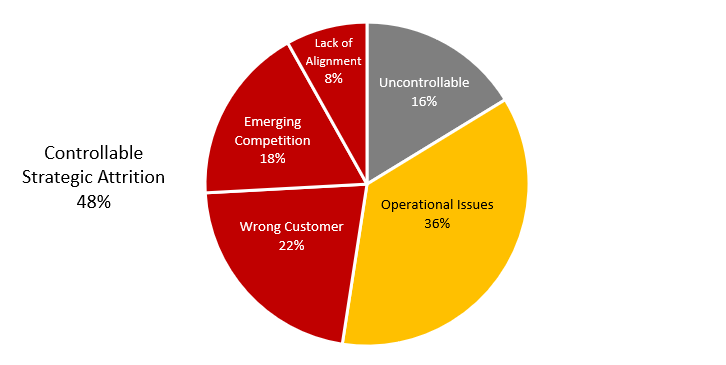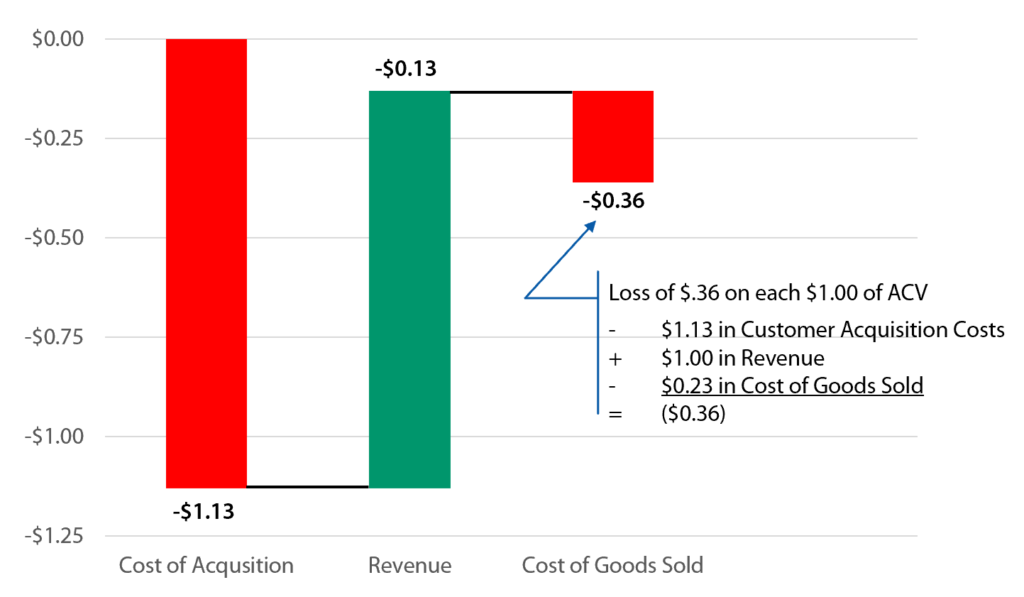What Drives Customer Attrition? It’s Not What You Think!
For good reason, customer retention is a critical metric for subscription-model businesses. When subscription businesses lose customers, they lose those customers’ entire future revenue streams.
Usually, businesses blame attrition on operational issues, including:
- Product quality problems
- A poor onboarding experience
- Account management deficiencies
- Lousy support
Nearly Half of All Attrition Is Due to Controllable Strategic Issues
However, in analyzing the true causes of attrition across our client engagements, we found that these usual suspects accounted for just 36% of attrition. Businesses lost another 16% of customers due to uncontrollable causes, that is, customers were acquired, went out of business, cancelled their projects, and so on. The remaining 48% are what we call Strategic Controllable Issues. These fall into one of three categories:
- Wrong customer
- Emerging competition
- Lack of alignment
Root Causes of Attrition (% of Lost Customers)

Source: Topline Strategy Analysis
Companies that don’t address these three issues are at best hurting their revenue and profitability, and at worst failing to recognize existential threats. But these issues are controllable, so it’s important to understand and evaluate them.
Defining Controllable Issues
Why are 48% of customers leaving businesses? Let’s look at the details.
- Wrong customers (22%): A wrong customer means there is a fundamental mismatch between what the customer needs and what your business offers. When a mismatch occurs, you’ll never be successful with the customer. In a license business, whatever downsides there are to having a wrong customer are more than offset by the value of the initial sale; however, in a subscription business, these customers actually cost money. On average, it takes 21 months to earn back the cost of acquisition for a typical SaaS customer. For each dollar in ACV sold to customers who last for only 12 months, companies lose $0.36.
First-Year Profitability on a Gross Margin Basis for Each $1.00 in ACV Sold to a New Customer

Source: KBCM 2018 SaaS Market Study, Topline Strategy Analysis
- Emerging competition (18%): Emerging competition is a particularly bad source of attrition because often, the customer is replacing a solution despite giving it a high NPS score. In some cases, a competitor moves into the market from an adjacent space and customers decide to consolidate with that new competitor. In other cases, customers move to an emerging competitor offering an innovative solution or far lower price point. In both cases, emerging competition can be a sign that a market is being disrupted.
- Lack of alignment (8%): Lack of alignment means customers no longer see the company as the horse to ride. Some view their needs as diverging from the company’s roadmap, others feel that the company is no longer as innovative, and still others believe that the company isn’t the market leader.
Tackling Controllable Issues
The first step in tackling Controllable Strategic Issues is data – you need to really understand why customers are leaving. The best practice is to have a formal exit interview program where product/market strategists call customers to gain deep insight into why customers leave. If you don’t have a formal program, then you’ll need to conduct a one-time study where you interview a critical mass of lost customers (a minimum of 25 to 30 but ideally 40 to 50).
You’ll then need to address the issues.
- Wrong Customers: Addressing the problem of wrong customers requires a change in focus for marketing and a change in mind-set for sales. For marketing, it means focusing on customers the business is likely to retain, not just those likely to buy. For sales, it means not selling to the wrong customers, even if they want to buy. This is not an easy task as marketing and sales are typically rewarded for business that comes in the door, but with the right training and incentives, it can be substantially improved.
- Emerging Competition: The key to evaluating competition is determining what is normal competition and what is truly emerging. The place to start is with your assumptions – Why are customers buying? What do you believe they need? What are your major differentiators? Then, you need to evaluate each loss against your assumptions. If the answer is that one of your assumptions no longer holds, you need to change your go-to-market strategy. Don’t ignore your competition and don’t give other companies time to get into your market.
- Lack of Alignment: This is usually the hardest to address. Do you change your roadmap and if you do, what does that do to your existing customers? Do you truly have an innovation issue and if so, how do you reinvigorate your team? There are no easy answers, but addressing the questions head on is the place to start.
Case Study: Wrong Customers
Consider an example of how one company solved its wrong customer problem. The company offered a technical support automation solution that was particularly valuable for organizations with a large number of low-skilled support staff, but not as useful for automating the processes around complex cases managed by highly skilled agents. Nearly half the companies that purchased the system for highly skilled agents never got into production and 75% left within 2 years of signing on.
To address the continued acquisition of wrong customers, the company changed its sales processes to make validating agent skill level a requirement for moving beyond Stage 2 in its sales pipeline, and began requiring VP-level approval to promote an opportunity past Stage 2 if skill level hadn’t been validated. Although continuing with deals without validating skill level wasn’t specifically banned, instituting VP-level approval made sales reps change their focus to opportunities where they didn’t need to ask for it, and this naturally pointed them to more appropriate customers.
The bottom line is that attrition is about a lot more than bad support or a poor onboarding experience. It’s crucial to identify controllable strategic issues and short circuit them before they harm your business beyond repair.
Do you understand your company’s true causes of attrition? The answer may surprise you.

